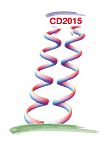Speaker
Liping Gan
(University of North Carolina, Wilmington)
Description
Light Meson decays provide a unique laboratory to probe fundamental QCD symmetries and to search for new physics beyond the Standard Model. A comprehensive Primakoff experimental program at Jefferson Laboratory (Jlab) is aimed at gathering high precision measurements on the two-photon decay widths and transition form factors at low Q2 of π0, η and η′ via the Primakoff effect. Completed experiments on the π0 radiative decay width at Jlab 6 GeV, and planned measurements of η and η′ at Jlab 12 GeV will provide sensitive probes to test the chiral anomaly and to study the origin and dynamics of chiral symmetry breaking in QCD confinement. On the other hand, a recently developed Jlab Eta Factory (JEF) experiment will measure various η decays. The experimental approach, which combines a state of the art PbWO4 crystal calorimeter, a 12 GeV tagged photon beam, and recoil particle measurement, will reduce the background by almost two orders of magnitude in the rare neutral modes compared to other competitors in the world. Reduction of the uncertainty on the light quark mass ratio will be achieved by increasing the world datasets for both the charged and neutral η → 3π Dalitz distributions by a factor of ∼ 3 while controlling systematic uncertainties with relatively flat detection efficiencies over the phase space due to significantly boosted η’s. A low-background measurement of the rare decay η → π0γγ will provide a clean, rare window into O(p6) in chiral perturbation theory, while offering a unique opportunity to search for a dark leptophobic gauge boson (B) in the 140-550 MeV mass range, with sensitivity to the baryonic fine structure constant αB as low as 10−7. The SM forbidden decays, such as η → 3γ and η → 2π0 γ, will allow the best direct constraints on new C violating, P conserving reactions. A overview of these experimental activities and their physics impacts will be presented.

